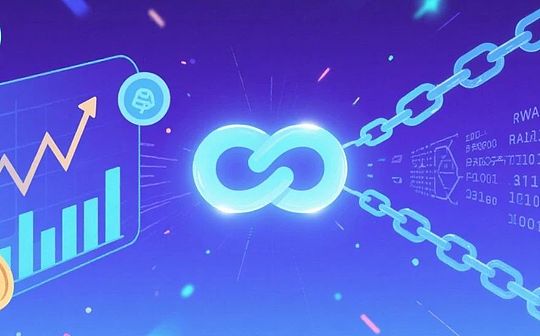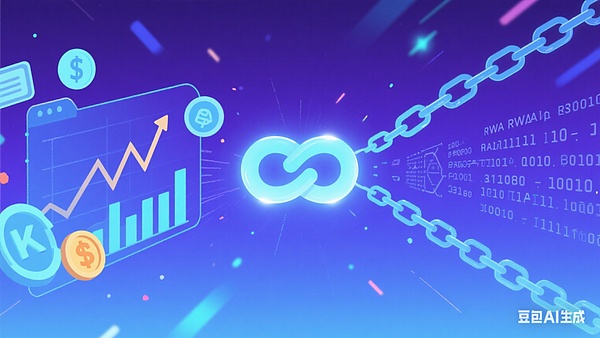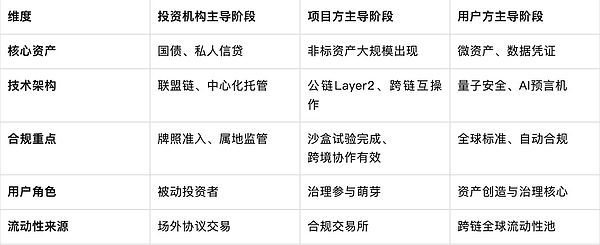
Author: Zhang Feng
1. RWA may present a three-stage evolution law
The diverse attributes of RWA, such as finance, technology, and industry, have become the core driving force of the stage in turn, and promote the migration of dominance from the capital side to the technology side to the demand side, and the path is naturally clear; at the same time, there are systematic differences in asset form, technical architecture, compliance framework and user rights and interests at each stage.Therefore, we believe that from the perspective of development path, RWA projects and ecological development will undergo a clear three-stage evolution—From the current investment institution-led stage, it transitions to the project-led stage, and finally moves to the user-led stage.

RWA’s three-dimensional attributes of finance, technology and industry jointly determine the development of the three-stage path of “investment institution-project party-user party”.
The financial attributes are the strongest in the early stages of advancing.RWA must comply with the specified price, rating and liquidity. Investment institutions will take the lead in completing asset chaining and market making with the advantages of funds and licenses to form a market benchmark.
The technical attributes were then highlighted.The project party has gradually gained the motivation to actively transform technology, mastering infrastructure such as chain reform, oracle, programmable contracts, etc., which can efficiently tokenize more physical assets and embed them into DeFi, reduce issuance costs, and expand supply.
Finally, the industrial potential energy is released.When the scale and return of the chain assets are large enough and the threshold for use is low enough, end users can directly hold, trade or mortgage RWA to obtain returns, realizing that “everyone is an asset operator.”
2. The leading stage of investment institutions
The current RWA ecosystem is dominated by traditional financial institutions and professional investment institutions, showing the characteristics of high threshold, strong supervision and credit valuation. Its core is to solve the liquidity dilemma and credit transmission problems of non-standard assets.
(I) Asset characteristics: mainly high-liquid financial assets
Private credit dominates.From a global perspective, the scale of 10 billion US dollars is mainly corporate loans issued by platforms such as Figure and Tradable, with an average annual interest rate of 9.74%, serving small and medium-sized enterprises that cannot obtain financing from traditional banks.
Treasury bondsTokenizationRise rapidly.Represented by BlackRock BUIDL Fund, the scale is US$2.41 billion, and the base is a US Treasury portfolio, supporting redemption as USD or USDC stablecoins, becoming the “risk-free return anchor” of the DeFi ecosystem.
A preliminary attempt at non-standard assets.For example, Hong Kong Delin Holdings tokenize Zhonghuan Commercial Property (valued at HK$280 million), but requires professional investor qualifications and limited liquidity.
(II) Technical characteristics: Alliance chain and centralized custody coexist.
The alliance chain leads the asset to be chained.For example, R3 Corda, Hyperledger Fabric, including domestic Ant Chain, etc., has become the first choice for financial institutions because of its controllable node access and KYC requirements.
Off-chain assets rely strongly on oracles.Physical gold (PAXG) and real estate require verification by licensed institutions, and the data is passed tokens on the Oracle price feeding map chain.
Smart contract functions are single.Focusing on basic issuance and dividend distribution, such as BUIDL’s automatic interest calculation function, complex governance still relies on centralized SPV.
(III) Compliance requirements: License and local supervision
Hong Kong promotes the sandbox system.The RWA regulatory sandbox that began in 2024 is constantly improving. At the same time, the “Stablecoin Regulations” that came into effect in August 2025 require stablecoin issuers to be licensed, and securities tokens require SFC case approval.
The United States clearly defines securities attributes.The SEC incorporates most RWAs into the securities framework and must comply with the Reg D/S exemption clause, and the financing limit is subject to the Regulation CF.
Cross-border compliance costs are high.Cross-borderThe project needs to meet the requirements of multiple jurisdictions such as the Securities and Futures Ordinance of Hong Kong and the SPV architecture of Cayman, which takes a relatively long time.
(IV) User rights: Professional investors are preferred
High threshold excludes retail investors.For example, most RWA project tokens are only distributed to “professional investors”, and require KYC certification and HK$1 million asset certification.
The right to income is better than the right to governance.BUIDL holders can earn interest, but asset strategy adjustments are not entitled to participate.
Exit dependency on centralized redemption.The US dollar redemption on the Securitize platform requires T+2 settlement, and liquidity is limited.
3. Project leader stage
With the maturity of technology and the promotion of regulatory sandboxes, physical enterprises and technology platforms have gradually seen the advantages of RWA, and have begun to have the motivation to increase the technological content, build internal and external trust, open ecological development, and have begun to become core drivers, and their goal is to revitalize their own asset liquidity and expand financing channels.
(I) Asset characteristics: physical assets are put on the chain on a large scale.
Non-standard assets have begun to become mainstream.In addition to supply chain finance (accounts receivable, orders), new energy assets (photovoltaic power stations), high-value assets such as intellectual property rights, cultural and creative industries and even other industries have entered the market.
Fragmented investment has begun to become popular.The threshold for real estate tokenization has been reduced to $50 per share. For example, the US RealT project supports retail investors to invest in real estate and collect rent stablecoins.
Stablecoins become pricing hubs.Platforms such as RWA Group support multi-chain stablecoins (USD/RMB/HKD) settlement to connect cross-border payments.
(II) Technical characteristics: Public chain Layer2 and cross-chain breakthrough
Layer2 basically solves performance bottlenecks.For example, in the future, low-gas fee chains such as Polygon support 7*24-hour transactions, shortening the settlement cycle from T+2 to second level, and improving efficiency by 90%.
Dynamic compliance begins to embed smart contracts.For example, the Rtree platform verifies investor qualifications through zero-knowledge proof and automatically implements KYC rules in different legal domains.
Offline assets-on-chain tokens begin to be anchored in two directions.For example, the gold token PAXG is linked to the LBMA vault 1:1, and the Internet of Things sensors monitor the asset status in real time.
(III) Compliance requirements: mutual recognition of regulatory frameworks and sandbox innovation
Hong Kong’s LEAP framework has been basically implemented.Promote mutual recognition of securities and commodity tokens and allow cross-border transactions.
The EU MiCA regulations are basically integrated.STO (Securities Token) is available in member countries, and Robinhood European Stock Tokens are regulated by MiFID II.
Sandbox further promotes compliance testing.Hong Kong Ensemble sandbox tests artworks NFT+revenue sharing and other hybrid models.
(IV) User rights: Governance participation in the bud
DAOGovernance begins to take effect.The platform has begun to create exclusive DAOs for RWA, and coin holders can vote to decide on asset disposal strategies.
On-chain revenue begins to be distributed in real time.Rents and interest are automatically distributed through smart contracts to avoid delays in traditional finance.
The liquidity mechanism is gradually improved.Start to access compliant exchanges, and some DeFi pools open to retail investors to provide liquidity.
4. User-side leading stage
When RWA’s underlying facilities are complete, the data utilization capability and efficiency will be greatly improved, and individual users and communities will become ecological centers, realizing the assetization and decentralization of user data rights and governance.
(I) Asset characteristics: personal assets and data voucher tokenization
The micro-asset vouchers are started to be put on the chain.Personal carbon points, social media data, creative copyrights, etc. are circulated on the chain.
User-generated RWA (UG-RWA) is becoming popular.For example, cross-border trade certificates tokenize + DeFi lending, individuals can issue assets based on order income rights.
A cross-chain global liquidity pool is gradually formed.The cross-chain exchange of gold, real estate, and treasury bond tokens, and the friction costs are approaching zero.
(II) Technical features: Quantum security and AI-driven DAO
Quantum encryption technology is beginning to ensure security.Guofu Quantum and others deploy quantum random number wallets to defend against quantum computing attacks.
AIDynamic pricing of the oracle machine begins to work.Replace traditional evaluation institutions and analyze the value fluctuations of non-standard assets in real time.
Fully automatic governance engine operation.DAO proposals, voting, and execution are completed in the entire chain, such as the Matrix system implementing “code is law”.
(III) Compliance requirements: Global unified standards
The RWA Identity Pass is gradually maturing.On-chain KYC credentials are universal across platforms and meet the requirements of multiple legal domains.
Automatic tax compliance operation.Smart contracts automatically withhold capital gains tax based on user nationality.
(IV) User rights: Data sovereignty and governance core
The data income rights confirmation is implemented.User behavior data can be tokenized and can be traded or mortgaged.
Decentralized governance is beginning to mature.The voting weight of the coin holder determines the asset strategy, such as whether to issue additional issuance, liquidation or cross-border cooperation.
User-led asset creation begins to operate.Individuals can issue “order income rights certificates” to form a UG-RWA (user generation of real-world assets) market.
Table: Comparison of RWA development characteristics in three stages

5. Current positioning and future challenges
At present, the global RWA ecosystem is clearly at the end of the dominant stage of investment institutions, and shows signs of transition to the dominant stage of project parties:
Institutional assets still dominate.Private credit + government bonds account for 87%, and traditional giants such as BlackRock and Figure control the pricing power.
The technical infrastructure needs to be mature, the mature, trusted and compliant blockchain issuance infrastructure needs to be polished, and the relevant technical agreements need to be further enriched., Hong Kong Ensemble Sandbox may play a corresponding exemplary role in the industry.
The regulatory system needs to be built and improved.The Hong Kong Stablecoin Ordinance, the US GENIUS Act, and the EU MiCA constitute the basic framework, but the system construction has not yet been formed, and cross-border mutual recognition is still missing.
However, the next stage of transition requires breaking through the three bottlenecks:
Technology-Compliance Closed Loop: The legal effect of oracle data requires judicial confirmation, and zero-knowledge proof must be compatible with GDPR.
Insufficient liquidity depth: Most RWAs currently rely on over-the-counter trading, the RWA trading market is far from reaching its due prosperity.
Rebalancing of user rights: The shift from “professional investor privilege” to the governance rights accessible to retail investors requires the reconstruction of the status of DAO legal entity.
Of course, what is mentioned above is roughly stage division. In fact, it is possible that the representative characteristics of the second and third stages may also be realized in some projects with high digitization in the first stage, and in the second and third stages, there will still be projects promoted by institutions, so this is not contradictory.It’s just a question of what type of project it is the main focus of for a stage.







